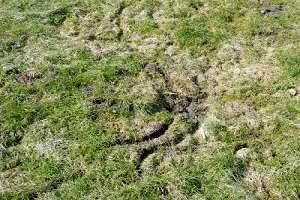By Amy Irish-Brown
As the 2016 apple harvest wraps up in many areas in Michigan in the next week or so, there are many tasks to get done before winter gets here. Michigan State University Extension suggests one task best done as soon as possible after harvest as the colder weather moves in is vertebrate management and specifically, vole and mouse management.

In many apple blocks this fall, you can find evidence of tunnels or runways of mice and vole activity. While it doesn’t appear to be unusually high traffic this fall, it is still present and an indication of rodents working in the area. With all the rain in the last few weeks, grass and weeds in orchard areas seem thicker than in some years, which could make rodent activity less apparent. Managing any vertebrate pest requires a preventative approach and with voles, it begins prior to snowfall once harvest is complete. Even if rodent activity appears lower right now, preventative management still needs to be considered to prevent future damage.
The rodents, often lumped together as “mice,” in an orchard system could be a deer mouse, a white-footed mouse or a vole. While they are different species with slightly different habitats, the management approach for all is the same. All mice in orchards can cause a significant amount of damage along the edges of blocks near drainage ditches or woodlots. Nearby corn or soybean fields can provide a fall food source for mice who will then move into the orchard and feed on trunks and roots.
Controlling vertebrate pests requires multiple approaches, which in general include exclusion, habitat modification, repellents, trapping and rodenticides. In an open and large scale commercial orchard setting, exclusion, trapping or repellents are not effective. This leaves habitat manipulation and rodenticides, and both are needed for a successful mice and vole abatement program.
Habitat modification such as a close mowing of grass in row middles and ditches late in the fall provides a two-fold management purpose – reduce favorable habitat for mice activity and expose rodents more readily to predators that help with population management. Cleaning up fencerows to reduce habitat is also needed.
Rodenticides are another approach in management programs, as they provide the quickest and most practical means of bringing large populations of mice and voles under control. Bait should be applied when dry and fair weather is predicted for at least three days and before any significant snowfall accumulation. If there is a great deal of alternate food (fallen apples in a block or nearby field corn), baiting might need to be done more than once to be most effective. If mice populations are very high, a second rodenticide application might be needed. As with any pest management program, but especially when using rodenticides, the risks to non-target organisms needs to be taken into account and prevented.
Source: msu.edu